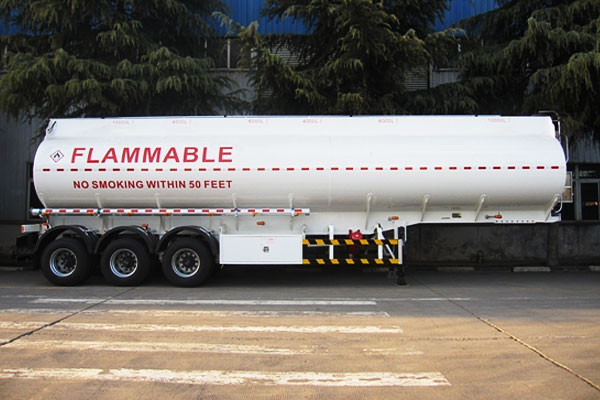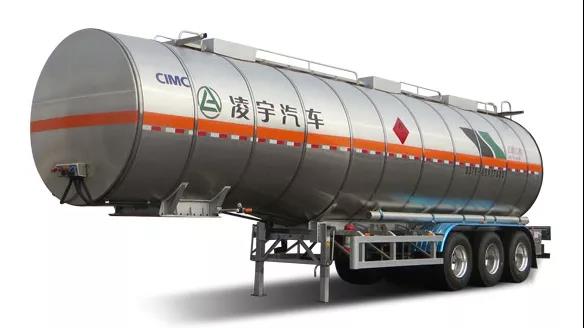Tank trucks are also known as mobile fuel trucks, computer tax-controlled fuel trucks, fuel tank trucks, fuel trucks, fuel trucks, oil trucks, oil trucks, edible oil trucks, and are mainly used as petroleum derivatives (gasoline, diesel) , Crude oil, lubricating oil, coal tar and other oil products) transportation and storage. According to different purposes and use environments, there are multiple oil refueling or oil transportation functions, such as oil absorption, pumping, and multiple oil distribution and distribution functions.
The tank truck is composed of a special vehicle chassis and an upper part. The upper part is composed of a tank body, a power take-off, a transmission shaft, a gear oil pump, and a pipe network system. The pipe network system is composed of oil pump, three-way four-position ball valve, two-way ball valve, filter screen and pipeline.
The structure of the oil tank is an elliptical cylindrical or trapezoidal cylindrical body, made of high-quality steel plate. The whole tank body is divided into single or multiple warehouses. The inside of the tank can be divided into compartments. The lower end of the intermediate partition has a through hole. Multiple bins, the bins can be divided into compartments, the lower end of the intermediate partition has a through hole, and the sub-bin reinforced wave partition is welded in the middle of each bin to reduce the impact of the oil in the tank when the car is sucked and increase the rigidity of the tank.

1. In order to ensure the cleanliness of the tanker, the tank and the oil delivery system should be cleaned regularly, and the internal and external joints of the two ends of the oil delivery hose should be frequently coated with lubricating oil, which is easy and convenient to disassemble and install the tanker. Clean the tubing in time after each work to ensure the cleanliness in the tubing;
2. The use and maintenance of the oil pump of the oil tanker shall be carried out in strict accordance with its operation and maintenance instructions;
3. Before refueling operation, you must use a power pole to insert into the wet ground, the tank truck grounding tape should be grounded, and the static electricity should be maintained during the operation;
4. The safety valve and filter net of the tanker should be checked and cleaned frequently;
5. Oil tank and pipeline system should be cleaned regularly. The tank truck regularly checks whether the joints of the pipeline system are well connected and the seal is reliable;
6. Oil tank trucks should install electrostatic belts in accordance with the specifications. When static electricity encounters the extremely high concentration of combustible gas remaining in the car, an explosion occurs. The electrostatic belt frictions frequently on the car body, etc., and can be effectively removed from the space where static electricity is easily generated. Static electricity hazards to ensure that the body is not harmed.
Install it on the metal part of the chassis! After using for a period of time, after the bottom part is worn out, you can put down some of the rubber band on it! If possible, users can install the tank truck electrostatic grounding alarm;
7. Tank trucks should be equipped with special fire extinguishers, and should be equipped with towing subway chains and electric poles. When driving, the towline chain should touch the ground; when refueling or draining, the electric pole must be inserted into the wet ground;
8. The oil tank filling hole should be tightly sealed, the oil drain valve and drain pipe should be free of leakage, the oil tank vent hole should be unblocked, the oil inlet filter of the oil pump should be cleaned frequently, and the two ends of the joint should be installed immediately after the oil delivery hose is used up Cover, no dirt can enter;
9. The vaporizer and exhaust pipe of the internal combustion engine must not have flashback. The exhaust pipe should be installed in front of the vehicle;
10. The staff of the oil tanker shall not wear shoes with nails. It is strictly forbidden to smoke near the oil tank, and fire is strictly prohibited;
11. When parking, keep away from the fire source, and choose to park in a cool place in the hot season. During thunderstorms, do not park under large trees or high-voltage lines. When parked in the middle of driving, a special person should be supervised;
12. During the maintenance process, if the operator needs to enter the oil tank, it is strictly forbidden to carry fire, and must have reliable safety protection measures, and there must be a dedicated person outside the tank;
13. All electrical devices on the car must be well insulated, and sparks are strictly prohibited. Car working lighting should be safety lights below 36V;
14. When the oil tank sedimentation tank is frozen, it is strictly forbidden to roast it with hot water, steam, or drive the car into the warm room to thaw;
15. When performing maintenance and overhaul under the vehicle, the internal combustion engine should be turned off, the hand brake should be tightened and the wheels should be tightened;
16. When a vehicle needs to be tested after being repaired, it should be driven by a qualified person. The vehicle must not carry people or objects. When it needs to be tested on the road, the test license issued by the traffic management department should be displayed;
17. When parking on a ramp, reverse gear should be used for downhill parking, first gear should be used for uphill parking, and a triangular wooden wedge should be used to plug the tires;

1. Do not pour gasoline into the carburetor port when the engine is running or when the car is cranking. Fill the carburetor with gasoline to increase the concentration of the mixed gas in the cylinder. Although this is helpful for starting when the oil does not enter the cylinder failure, it will not help the failure caused by other reasons, and it may also cause a return. Fire, burn people and burn down vehicles and other hazards.
2. When maintaining the gasoline filter, it is not recommended to burn the filter core with gasoline. Many people like to use gasoline to burn the ceramic filter element to remove impurities on the filter element when maintaining the gasoline filter. The hazard of this is that it is easy to catch fire and at the same time affects the life of the filter element.
3. In the oil depot, it is not allowed to check the battery storage by short-circuiting. Because in poorly ventilated small oil depots, tires, batteries, tarpaulins and other equipment are often placed, and there is spilled gasoline on the ground, and sparks generated during a fire are likely to ignite the oil molecules in the air.
4. The tow train chain of the oil tanker is not allowed to be wound on the girder. Like other substances, oil also generates static electricity when rubbing against another object. This kind of static flashover may ignite the fuel and cause a fire. Therefore, a grounded ground wire must be installed on the oil depot, and a grounded iron chain must be installed on the oil tanker to prevent static sparks in the oil tank. This iron chain must not be wound on the frame of the beam. On the ground, and the mopping section is not less than 50 cm.
5. It is strictly forbidden to refuel under the high-voltage wires.
6. The hanging fire method is not allowed to be used frequently. Sometimes car spark plugs have carbon deposits. When the carbon deposits in a certain cylinder are severe, the cylinder cannot work normally. In order to make the cylinder work normally, the method of “hanging fire” outside the cylinder is adopted (leave 3 between the spark plug and the high-voltage line). Mm—4 mm gap) to increase the spark-over energy of the spark plug electrode and restore the cylinder to work, but the general “hanging” method is easy to fall off if you are not careful. If there is dripping gasoline on the cylinder, it is extremely prone to fire. Therefore it is only a temporary remedy. The correct treatment should be to clean and maintain the spark plug in time, and try to avoid using the "hanging fire" method.
7. No leaks in the automobile oil system. If there is a drip in the oil circuit of the chassis, and it is encountering a late ignition point and a lean point of the mixture, the exhaust pipe will ignite due to the slow combustion, and the temperature of the body will rise, more than ten times the ignition point of gasoline vapor (gasoline vapor The ignition point is 28°C). If the leaked oil is ignited, it is very easy to cause fire and cause the car body to be scrapped. If the carburetor part drips on the cylinder head, the high-voltage spark leakage of the spark plug may also cause a fire.
Detailed explanation of tanker structure performance
Summary of common problems of concrete mixer truck
Twenty pure electric concrete mixer trucks delivered; authoritative media in Zhumadian witness the industry's low-carbon upgrade.
2025-12-18 16:43100 units delivered, 1000 units achieved! CIMC Vehicles' DTB mixer truck business group, together with FAW Jiefang and CATL, jointly support Xinxiang's new journey of green development
2025-12-12 14:00CIMC Vehicles and Shaanxi Heavy Truck jointly launched their New Energy 4.0 products, deepening the new ecosystem of intelligent integrated trailer-mounted vehicles
2025-12-12 11:30The core secrets of CIMC Vehicles' "Lighthouse Factory"! A visit to the DTB mixer truck intelligent manufacturing base
2025-12-12 10:58Address:Zhangheng Street corner Guanlin Road, Science and Technology Park, Luolong District, Luoyang City, Henan Province
E-mail:shiyk@lingyu.com
Phone:0086-379-65937678